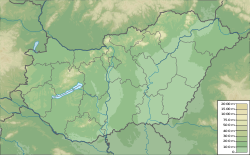Miskolc Synagogue
| Miskolc Synagogue | |
|---|---|
 The synagogue in 2005 | |
| Religion | |
| Affiliation | Orthodox Judaism |
| Rite | Nusach Ashkenaz |
| Ecclesiastical or organisational status | Synagogue |
| Status | Active |
| Location | |
| Location | Miskolc, Borsod-Abaúj-Zemplén |
| Country | Hungary |
Location of the synagogue in Hungary | |
| Geographic coordinates | 48°06′14″N 20°47′07″E / 48.1040°N 20.7852°E |
| Architecture | |
| Architect(s) | Ludwig Förster |
| Type | Synagogue architecture |
| Style | |
| Date established | 1850s (as a congregation) |
| Groundbreaking | 1856 |
| Completed | 1862 |
| Materials | Brick |
| [1][2] | |
The Miskolc Synagogue, also called the Kazinczy Street Synagogue or the Great Synagogue of Miskolc, is an Orthodox Jewish congregation and synagogue, located in the town of Miskolc, in the county of Borsod-Abaúj-Zemplén, Hungary. It is the only remaining synagogue in the Borsod-Abaúj-Zemplén county.
History[edit]
The synagogue was designed by Ludwig Förster and built between 1856 and 1862 in Romanesque Revival and |Rundbogenstil styles. Its Kazinczy Street façade has a rose window and narrow Gothic Revival windows. The synagogue has three aisles. The women's balcony is supported by slim iron pillars decorated with Gothic Revival and Byzantine Revival elements. The painting of the walls feature ornamental Eastern design.
When designing the synagogue, Förster made some innovations: he had an organ built and the Torah reader's platform was put before the Ark, not in the centre of the synagogue. These innovations were rejected by the Orthodox majority of the city's Jews, and in the year following the opening of the synagogue a rabbinical assembly in Sátoraljaújhely excommunicated the rabbi of Miskolc. The congregation decided to remove the organ from the synagogue and put the platform in the centre, in accord with tradition.
This event led to a split in the Jewish community, and the local Hasidim ("Sefardim") separated from the rest, building a small place of worship in Kölcsey street, which no longer survives. Another synagogue, built in Pálóczy Street in 1817, was demolished in 1963.
According to the 1920 census, Miskolc had approximately 10,000 Jewish residents (16.5% of the total population) but the majority of them fell victim to The Holocaust. At the Déryné Street entrance to the synagogue are marble tablets commemorating the Holocaust. Another commemorative plaque can be seen in János Arany Street, where the ghetto once was.
As of 2001[update], the city had approximately 500 Jewish residents.[citation needed]
See also[edit]
References[edit]
- ^ "Great Synagogue in Miskolc". Historic synagogues of Europe. Foundation for Jewish Heritage and the Center for Jewish Art at the Hebrew University of Jerusalem. n.d. Retrieved July 13, 2024.
- ^ "Great Synagogue in Miskolc, Hungary". The Bezalel Narkiss Index of Jewish Art. Foundation for Jewish Heritage and the Center for Jewish Art at the Hebrew University of Jerusalem. n.d. Retrieved July 13, 2024.
External links[edit]
- Picture of the Kazinczy street synagogue
- Some information and a picture of the synagogue of Pálóczy street
- A picture of the inside of the Kazinczy street synagogue (with a short Hungarian-language article)
- 1862 establishments in the Austrian Empire
- 19th-century synagogues in Hungary
- Buildings and structures in Miskolc
- Jewish organizations established in 1862
- Orthodox synagogues in Europe
- Romanesque Revival architecture in Hungary
- Romanesque Revival synagogues
- Rundbogenstil synagogues
- Synagogues completed in 1862
- Synagogues in Hungary

